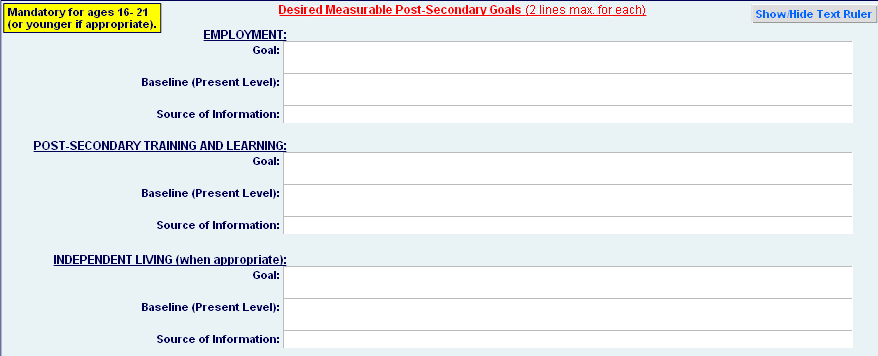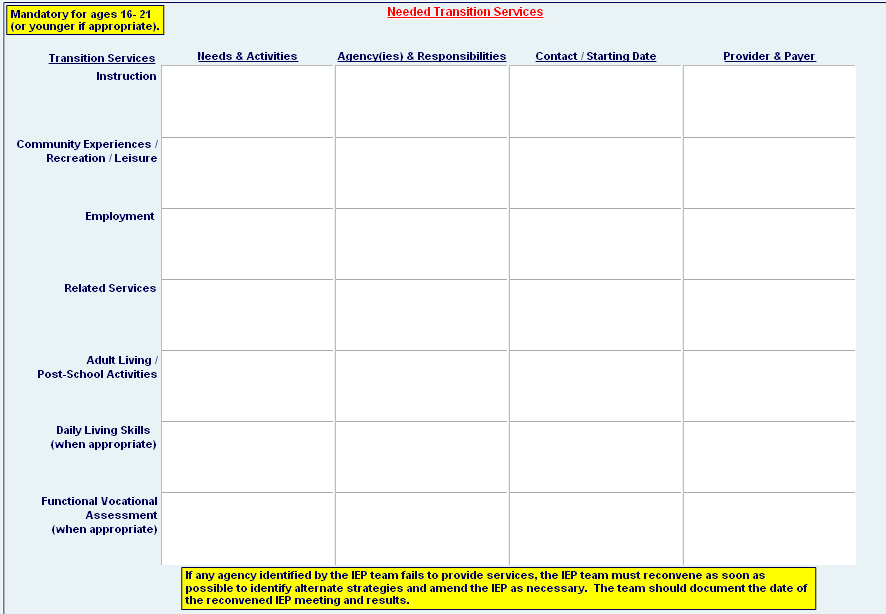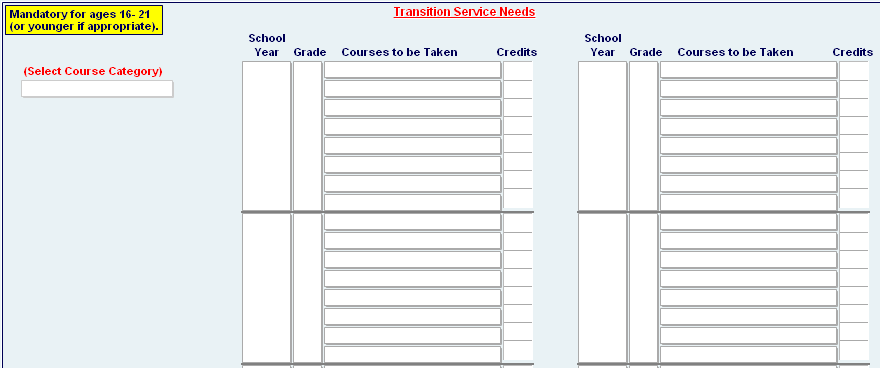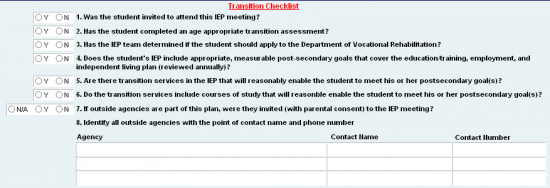Anticipated Grad Date – Transfer of Rights Letter – Post-Secondary Goals – Domain Definitions – Transition Services – Transition Courses – Transition Checklist
View Sped Manual entry on Secondary Transition
Secondary transition planning is required for all students on an IEP beginning at age 16 (or younger if determined appropriate by the IEP team). Because the plan must be in place by the time the student turns 16, secondary transition planning should be a part of the IEP process for any student who is 15 years old, as that student will turn 16 during the course of their annual IEP. The transition plan should define the student’s post-secondary goals, and the necessary courses, services, and learning opportunities that will help the student achieve those goals.
Anticipated Graduation Date

The date that is entered here should be consistent with the student’s same age peer group or determined by the number of high school credits the child has accumulated. If the IEP team determines that the student will participate in their educational program for an extended period of time (not to exceed age 22) it will be up to the team to determine when the expected graduation date will be. For diploma-track students, graduation is used in the sense of the child completing all graduation requirements and receiving a regular diploma. For students who are not on a diploma track, this will be the date when the student will exit high school and/or receive a certificate of attendance or completion.
Date by Which Transfer of Rights Letter Must Be Sent
This date is automatically calculated. It is 17 years from the date of birth. As stated in the IEP Entry section of this handbook, it is the responsibility of SPED Central Office personnel to send the Transfer of Rights letter to the student. The date is displayed so you as case manager know the letter has indeed been sent when it should have been.
Desired Measurable Post-Secondary Goals
Employment – Post-Secondary Training & Learning – Independent Living – Baselines

In its most basic form, the transition goals should be focused on having the student become as self-supportive and independent an adult as possible. It is important to include the student in the process of developing these goals. The IEP team needs to develop a vision or plan which includes all the elements that are necessary for the student to make reasonable progress toward these overall goals. These goals must be post-secondary, meaning the outcomes will be attained after the student exits high school. These must be measureable goals, using definitive terms and outcomes rather than merely noting student interests or aptitudes.
Employment
Post-secondary goals related to employment should focus on occupational categories instead of specific jobs. If the student has a specific career that they have identified and it is reasonable for them to attain it, then transition activities should relate to that outcome.
The Team should address these areas in relation to the specific employment areas:
(a) the occupational needs, interests, and aptitudes;
(b) following directions, working at a satisfactory rate, and accepting supervision;
(c) searching for a job through the want ads and personal networking, applying for a job, and interviewing for a job. (Back to Goals)
Post-Secondary Training and Learning
Planning for post-secondary activities recognizes that not all young people will seek employment immediately after they leave high school. Some students will want to further their education while others will seek vocational or technical programs to build skills for specific occupations. Goals in this area should be focused on whether the student intends to pursue an academically or technically oriented education after high school, and the nature and severity of the student’s disability as it affects the ability of the student to pursue post-secondary education. (Back to Goals)
Independent Living (when appropriate)
The Team must consider the level of independence that the student is likely to reach at adulthood. One of the issues that need to be considered is where the student will live. Some students will be staying in their family’s home, but may also need to explore other arrangements for establishing community living opportunities in the future. Other students will attend a post-secondary institution that provides housing for the student. Still others may need the intensive support of foster homes, group homes, semi-independent living situations, supervised housing, intermediate care facilities, and comprehensive care facilities that provide nursing services. (Back to Goals)
Baseline for Secondary Transition Domains
For each of the domain areas the IEP Team needs to identify the present level the student is at and the specific source of the information that the level was determined from. Sources that would be valid would be teacher observation, student interview, parent interview, formal or informal vocational and developmental checklists or assessments, as well as all other information that is a valid representation of the student’s abilities. The statement for each area is a short synopsis of the skills the student possesses at the current time. (Back to Goals)
Definitions for Domain areas:
Employment:
The team should specify the baseline skills the individual possesses in relation to the career area that was identified as a goal after high school.
Post-Sec. Training and Learning:
The team needs to identify what skills the individual presently has or experiences they have been exposed to, as well as any post-secondary education or training they will need in the future. These services could be provided by the school or other agencies.
Independent Living:
This area relates to skills and knowledge of what adults do on a daily basis. Define the skills the student has and what will they need to achieve the highest level of independence after high school. A few examples are food purchase and preparation, money management, reading survival words and signs, using phone books and other directory resources, reading help wanted ads, movie schedules, bus schedules, and personal hygiene.
Needed Transition Services

The IEP Team must consider, at a minimum, the following areas for transition services: instruction, related services, community experiences, employment, and post-school adult living objectives. If it is determined appropriate, then the transition IEP must also address daily living skills and the need for a functional vocational evaluation. While the IEP Team may determine that a student does not require services in all transition planning areas, this decision should be made based on the individual needs of the student after carefully considering each planning area. A brief description of each planning area follows:
- Instruction – use of formal techniques to impart knowledge. Typically provided in schools, but could be provided by other entities in other locations.
- Community Experiences/Recreation/Leisure – services provided outside of the school building, in community settings or other agencies. This may also include extracurricular offerings through the school.
- Employment – Services aimed at helping the student gain experience and/or build the prerequisite skills necessary for employment.
- Related Services – transportation and such developmental, corrective, and other supportive services as are required to assist a student with a disability to benefit from special education. This could include speech/communication therapy, Occupational Therapy, Physical Therapy, etc.
- Adult Living/Post-School Activities– services that address where the student will live after high school, and how the student will engage in important adult activities and be active participants in their community. Services could be provided by schools or other agencies.
- Daily Living Skills (when appropriate) – basic life skills that adults use every day, i.e. buying and preparing food, personal hygiene, personal finance, housekeeping, etc. Services could be provided by schools or other agencies.
- Functional Vocational Assessment (when appropriate) – assessment that provides information about job or career interest, aptitudes and skills. Assessments could be provided by school or other agencies.
**Please keep in mind that the district is ultimately responsible for ensuring that needed transition services are provided for students. If an outside agency that is listed in the transition plan fails to provide the transition services, the district may be responsible for finding an alternative means for providing the necessary services.
Transition Courses

In this section use the pull down menus to outline the classes that allow the student to progress in the general education curriculum toward a regular high school diploma or to the identified transition focus selected by the student’s team. Select a course category from the (Select Course Category) drop down list on the left. Choosing a category from this list, will create a corresponding drop down list under “Courses to be Taken.”

Courses selected should reflect the regular education curriculum unless the student’s educational program is modified to the point that the student is working on a non-diploma track. Most students should be working on the regular curriculum and working toward earning a high school diploma, unless they have significant delays in development.
For diploma-bound students in high school, the IEP Team should map out the classes needed to earn a high school diploma. If the student is not working toward a diploma, this section should lay out the classes that are needed to reach the transition goal for the student.
The database will keep a running tally of “Total Planned Credits” for each transition student. A minimum of 22 credits are required to earn a high school diploma. All diploma-track students should have at least 22 credits included on their transition plan. If you find this number to be unusually high or low, check that the credits assigned to each particular course (ex. half credit versus full credit) are correct. This number will not print on any paperwork, but is simply meant as a guide to help ensure that transition plans are complete and include all necessary coursework.
Transition Checklist
At the bottom of the Secondary Transition section is a “Transition Checklist” that must be completed for every transition-age student. These questions are aimed at ensuring that each student’s plan is complete, appropriate, and updated annually.
Please use these questions as a guide to review each transition plan once it is complete. If you find that the answer to any of these questions is “No,” you will need to take corrective action to review and revise the student’s transition plan. The data in each of these fields will be cleared annually, as every student’s transition plan must be carefully reviewed and updated each year to ensure that it is complete and up-to-date.

